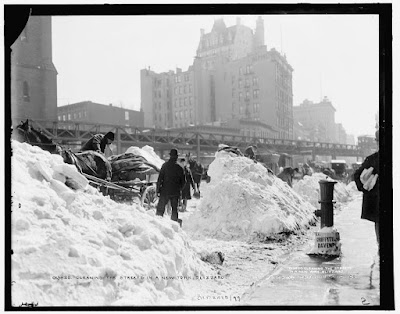About
a year ago I wrote here about Winter Weather, citing a few examples of how cold
snaps and ice storms have wreaked havoc. Last November I again described the
cold weather we had in Baby, it’s cold outside!
Well,
here we are again in the dead of winter experiencing more frigid weather and
over-the-top precipitation. I have also said before, while it may be news, this
is not new. We are not expecting blizzards where I live but right now it is
very cold!
As
I write this is the temperature is -28℃ (1℉) outside and the dogs were very
quick to do their business and get back inside the warm house. The prognosis
for the next few days is not great either.
 |
| 14-day forecast for Calgary, Alberta |
The
week was forecast to be pretty nasty for much of North America as well.
 |
A colorful surface
forecast map by the 12Z GFS for 11 January 2020 depicting a multi-hazard event
with significant snow (blue) and ice (purple, pink) on the cold side of a
powerful storm system and heavy rain (green, yellow) on the warm side where
there will be a severe weather threat as well. Map courtesy NOAA/WPC,
tropicaltidbits.com
If
you have lived on the prairies for any length of time you have observed cold
and storms. Central North American is famous for its blizzards, going back as
far as people can remember. The Eastern coast is not unfamiliar with harsh
weather, either, especially in the winter. Europe has had its share of storms
Search
the internet and you will find numerous stories of great storms that pounded farms
and cities, almost every decade. Becky Oskin, writing for Live Science in 2013
listed The 10 Worst
Blizzards in US History. :
·
The Great Blizzard
of 1888
(11, 12 March 1888) hit the Northeast, killing over 400 people
·
The Great Blizzard
of 1899
(11 February 1899) struck the region from Georgia to Maine
·
The Storm of the
Century
(12 March 1993) caused devastation and the deaths of 310 people from Cuba to
Canada
·
The White
Hurricane
(7 November 1913) pummeled the Great Lakes region causing 250 deaths
·
The Children’s
Blizzard
(13 January 1888) swept across the Dakota Territory and Nebraska where 235
people died
·
The Great
Appalachian Storm
(24 November 1950) killed 353 as it moved from North Carolina around to Ohio (I
wrote about this one here)
·
The Knickerbocker
Storm
(27, 28 January 1922) when several feet of snow fell on Maryland, Virginia and
Pennsylvania
·
The Armistice Day
Blizzard
(11 November 1940) raged over the Midwest building 20-foot snowdrifts and
killing 145 people
·
The Super Bowl
Blizzard
(9 January 1975) was a record low pressure system that spawned tornadoes in the
Southeast US as well as high winds and snow in the Midwest
·
Snowmaggeddon (February 2010)
was the name given to a major blizzard that broke snowfall records in the
mid-Atlantic region
Other
writers have described other major winter events. I wrote about a book that
summarized many of these in a blog post last year, New England Storms. One of earliest
winter storms listed struck New England on 6 February 1717, after an already
cold and snowy two months. Snow drifted above tree tops, burying or causing
great suffering for animals both domestic and wild, and the deaths of over 400
people.
Europe
experienced the deadly Beast from the East in February 2018
as gales and blizzard conditions reached from Siberia to the Atlantic. The
storm paralyzed the continent left thousands homeless.
 |
Satellite view
showing Europe, including Great Britain and Ireland partially covered in snow
under the influence of the strong cold wave on 27 February 2018
|
Jodi
Smith, writing for Ranker listed many other major winter storms in Europe and
Asia:
·
Iran
Blizzard (February 1972) dumped snow over 200 villages and claimed 4,000 lives
·
Carolean
Death March (12 January 1719) was a forced retreat of Swedish soldiers who were
caught in a raging storm in the Tydal Mountains with over 3,000 men killed.
·
Afghanistan
Blizzard (February 2008) was the worst storm on record in the country when 900
people and 230,000 livestock died.
·
Hakkoda
Mountains Incident (January 1902) that took a regiment of Japanese soldiers by
surprise killing almost 200 of them
·
Chinese
Winter Storms (January and February 2008) saw the worst storms in over 50
years, pummeling the countryside and crippling the transportation network
The
United Kingdom witnessed a severe winter in 1894-95 when 100s of people died.
Other devastatingly cold periods, many with great snowfalls, afflicted the
country in 1946-47, 1962-63 (The Big Freeze), January 1987, 1990-91, 2009-10,
2010-11 and 2012. The latter affected all of Europe. And then there were the
Great Frosts of 1709 and 1739-40.
Extreme minimum
temperature February 4 - February 11, 2012 across Europe
In
March of 1891, The Blizzard in the West
struck Cornwall and Devon, and with snow drifts piled up tens of feet in many
areas, halting all trains and communication.
The
list of cold winters and major blizzards is endless. Each year many of us in
the North Hemisphere experience at least one big snowstorm. Reading of
historical news reports demonstrates these have been common events for at least
the last few hundred years.
We
are much better informed and protected now that people were 100 or 200 years
ago, but severe winter storms still catch and kill people and cause significant
damage.





No comments:
Post a Comment